|
The Volunteer Defence Corps (VDC) was an Australian part time volunteer military force of World War 11 modeled on the British Home Guard. The VDC was established in July 1940 by the Returned and Services League of Australia (RSL) and was initially composed of distinguished ex-servicemen who had served in World War 1, but were too old for frontline service.
Names of known Gnowangerup VDC members are as follows: William Adshead, Eli Atwell, Reg Austin, Charles Barnard, Ray Beeck, Charlie Black, A. H. Bluntish, Thomas Butcher, William Carter, Dick Chambers, Claude Cockram, Arthur Cook, Clarence Davies, Norman Davis, Charlie Denny, Stan Dolley, Archibald Dolley, Norman Drummond, Harry Farrant, John Fennell, Peb Flanagan, Albert Freegard, Galloway, Benjamin Garnett, Fred Gaze, William Gaze, Raymond Harris, J. Heath, Edward Hill, Eric Hinkley, Reuben Hinkley, Leslie Jones, Harry Lower, June Marsh, Lionel Marsh, William McDonald, Miles McDonald, William McInnes, Nigel Moffat, William Murray, Frank Norris, Dick Parnell, George Pinney, Richard Pozzi, Bertie Rout, Thomas Scott, Alexander Simpson, Norman Skewes, Harold Smith, David Spence, Sam Stewart, John Stewart, Tommy Stewart, Leo Treasure, Joseph Weir, George Wellard, Andrew Wellstead, Edward Wellstead, Arthur John White, John Witt, George Whitt, Charles Arthur Whyatt.
|
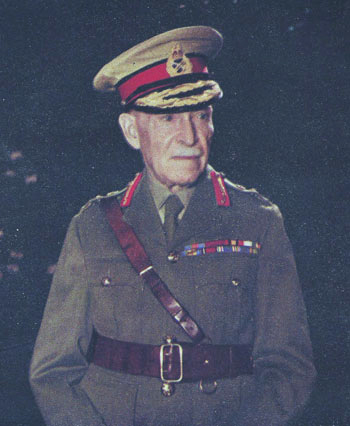
INSPECTOR-IN-CHIEF, VOLUNTEER DEFENCE CORPS,
GENERAL SIR HARRY CHAUVEL., G.C.M.G., K.C.B. #1
|
|
General Harry Chauvel, who had retired in 1930 was recalled to duty in 1940 and was appointed Inspector General of the VDC. Chauvel held this position until his death in March 1945.
Originally the government only supplied some weapons, but from 1941 on, it supplied standard army uniforms and eventually took over the running of the organisation completely. The VDC was never well equipped however. But by the time the war with Japan began it had a strength of 44,000. Some 5,000 men of the VDC were soon called up for full time service as coast watchers, airfield defence and security guards in order to free up younger men for combat use. Following the outbreak of the Pacific War, the Government expanded the VDC in February 1942. Membership was open to men aged between 18 and 60, including those working in reserved occupations. As a result the VDC reached a peak strength of almost 100,000 in 1942, with the VDC being responsible for collecting local intelligence and providing static defence of each unit's home area and key installations. They were also responsible of training for full scale guerrilla warfare if the Japanese invaded.
|

VOLUNTEER DEFENCE CORPS MARCHING
BEFORE BEING ISSUED WITH UNIFORMS #2
|
|
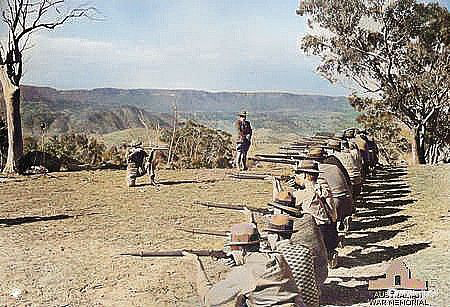
VOLUNTEER DEFENCE CORPS PRACTISING THERE MARKMANSHIP #3
|
The VDC men wore green uniforms which included the familiar Aussie slouch hat. Some were armed with .303 rifle and Vickers or Lewis machine guns, while others had to improvise. In the absence of suitable equipment for training purposes, members of the Volunteer Defence Corps (VDC) took it upon themselves to fashion their own examples of mortars, machine guns, rifles and grenades. Their efforts range from the crude and dangerous to the relatively sophisticated. Unsurprisingly, a number of accidents were recorded among VDC member using homemade weapons during the war.
A ready made base for the VDC were the Australian rifle clubs under the banner of the National Rifle Association, which was then associated with the Department of Defence. Rifle club members were highly skilled rifle men, well versed in the handling of firearms and ready for the task involved. Every Australian town of any significance, including Gnowangerup, has boasted at least one rifle club. In Western Australia alone there were 128 rifle clubs affiliated to the Western Australian Rifle Association, with a membership of about 12,000 rifle men.
|
|

VOLUNTEER DEFENCE CORPS PHYSICAL EXERCISING #4
|

VOLUNTEER DEFENCE CORPS GUERRILLA TRAINING #5
|
|
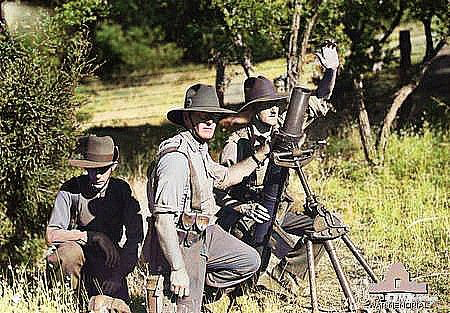
VOLUNTEER DEFENCE CORPS MORTAR PRACTISE #6
|

VOLUNTEER DEFENCE CORPS PRACTISING GRENADE THROWING #7
|
|
To further training of such a body of men, the defence department was issuing free ammunition and heavily subsidized the purchase cost of the rifles. Every able bodied man considered it to be his duty to belong to the rifle club in order to attain the highest shooting skills and get ready to fight the enemy. The great metropolitan area boasted 44 rifle clubs which were sharing the use of the established rifle ranges at Swanbourne, South Perth, Queens Park, Armadale, Bedfordale, Kalamunda, Midland Junction, Mundaring and Chidlow. Such was the interest in rifle training that there just wasn't enough rifle ranges, especially in the metropolitan area, to accommodate all.
To alleviate the rifle ranges shortage, the Defence Department asked members of VDC for help to build more rifle ranges. VDC members considered it to be their patriotic duty to take up the challenge and in a short time about half dozen rifle ranges sprung up in the wider metropolitan area. The rifle ranges at Byford, Mt. Helena, Wooloroo, Jarrahdale, Bullsbrook, Bushmead and Byford were built.
|
|
In 1942 the Japanese invasion was imminent so all schools were told to prepare air raid shelters for the children. The Headteacher of the Gnowangerup School instructed the children on how to dig air raid shelter trenches in the school grounds. They also started practicing air raid drills
|
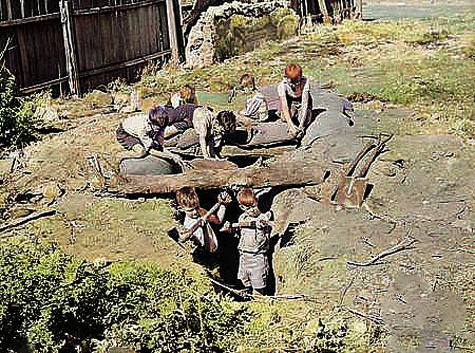
CHILDREN DIGGING A BOMB AND AIR RAID SHELTER #8
|
|
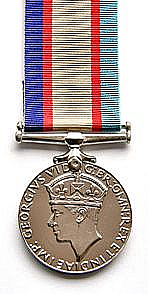
AUSTRALIAN SERVICE MEDAL 1939-1945 #10
|
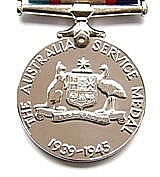
AUSTRALIAN SERVICE MEDAL 1939-1945 #9
The Australia Service Medal 1939-1945 was instituted in 1949 to recognise the services of the Australian Armed Forces and the Australian Mercantile Marine during World War 11. It is made of nickel silver with the crowned effigy of King George VI on the obverse. The reverse has the Australian coat of arms, placed centrally, surrounded by the words 'AUSTRALIAN SERVICE MEDAL 1939-1945'. Members of the VDC were awarded the Australian Service Medal for three years part time service. Some who served full time qualified for the War Medal. Some served in the Darwin Region and qualified for the Defence Medal.
Members of the VDC were awarded the Australian Service Medal for three years part time service. Some who served full time qualified for the War Medal. Some served in the Darwin Region and qualified for the Defence Medal.
|
|

